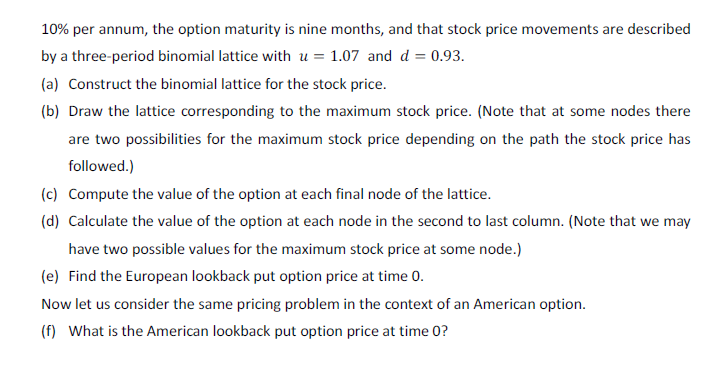

Numerous variations on the basic design of options have been proposed. These "nonstandard" options are sometimes called as exotic options. One example is a lookback option. In a lookback option the effective strike price is not specified, but is determined by the minimum (in the case of a call) or maximum (in the case of a put) of the price of the underlying asset during the period of the option. Consider pricing a European lookback put option on a non-dividend-paying stock. At maturity T, this pays off the amount by which the maximum stock price between time 0 and time I exceeds the stock price at time T. Suppose that the initial stock price is $300, the risk-free interest rate in continuous compounding is 10% per annum, the option maturity is nine months, and that stock price movements are described by a three-period binomial lattice with u = 1.07 and d = 0.93. (a) Construct the binomial lattice for the stock price. (b) Draw the lattice corresponding to the maximum stock price. (Note that at some nodes there are two possibilities for the maximum stock price depending on the path the stock price has followed.) (c) Compute the value of the option at each final node of the lattice. (d) Calculate the value of the option at each node in the second to last column. (Note that we may have two possible values for the maximum stock price at some node.) (e) Find the European lookback put option price at time 0. Now let us consider the same pricing problem in the context of an American option. (f) What is the American lookback put option price at time 0? Numerous variations on the basic design of options have been proposed. These "nonstandard" options are sometimes called as exotic options. One example is a lookback option. In a lookback option the effective strike price is not specified, but is determined by the minimum (in the case of a call) or maximum (in the case of a put) of the price of the underlying asset during the period of the option. Consider pricing a European lookback put option on a non-dividend-paying stock. At maturity T, this pays off the amount by which the maximum stock price between time 0 and time I exceeds the stock price at time T. Suppose that the initial stock price is $300, the risk-free interest rate in continuous compounding is 10% per annum, the option maturity is nine months, and that stock price movements are described by a three-period binomial lattice with u = 1.07 and d = 0.93. (a) Construct the binomial lattice for the stock price. (b) Draw the lattice corresponding to the maximum stock price. (Note that at some nodes there are two possibilities for the maximum stock price depending on the path the stock price has followed.) (c) Compute the value of the option at each final node of the lattice. (d) Calculate the value of the option at each node in the second to last column. (Note that we may have two possible values for the maximum stock price at some node.) (e) Find the European lookback put option price at time 0. Now let us consider the same pricing problem in the context of an American option. (f) What is the American lookback put option price at time 0








